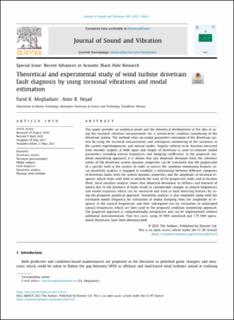| dc.contributor.author | Khazaeli Moghadam, Farid | |
| dc.contributor.author | Nejad, Amir R. | |
| dc.date.accessioned | 2021-10-22T08:52:25Z | |
| dc.date.available | 2021-10-22T08:52:25Z | |
| dc.date.created | 2021-05-31T10:58:04Z | |
| dc.date.issued | 2021 | |
| dc.identifier.citation | Journal of Sound and Vibration. 2021, . | en_US |
| dc.identifier.issn | 0022-460X | |
| dc.identifier.uri | https://hdl.handle.net/11250/2824933 | |
| dc.description.abstract | This paper provides an analytical proof and the theoretical development of the idea of using the torsional vibration measurements for a system-level condition monitoring of the drivetrain system. The method relies on modal parameter estimation of the drivetrain system by using the torsional measurements and subsequent monitoring of the variations in the system eigenfrequencies and normal modes. Angular velocity error function extracted from encoder outputs at both input and output of drivetrain is used to estimate modal parameters including natural frequencies and damping coefficients. In the proposed condition monitoring approach, it is shown that any abnormal deviation from the reference values of the drivetrain system dynamic properties can be translated into the progression of a specific fault in the system. In order to extract the condition monitoring features, local sensitivity analysis is engaged to establish a relationship between different categories of drivetrain faults with the system dynamic properties and the amplitude of torsional response, which helps with both to identify the state of the progressive faults and to localize them. Local sensitive analysis shows that abnormal deviations in stiffness and moment of inertia due to the presence of faults result in considerable changes in natural frequencies and modal responses which can be measured and used as fault detecting features by using the proposed analytical approach. Sensitivity analysis is also employed along with the estimated modal frequency for estimation of modal damping from the amplitude of response at the natural frequencies and their subsequent use for estimation of undamped natural frequencies which are later used in the proposed condition monitoring approach. The proposed approach is computationally inexpensive and can be implemented without additional instrumentation. Two test cases, using 10 MW simulated and 1.75 MW operational drivetrains have been demonstrated. | en_US |
| dc.language.iso | eng | en_US |
| dc.publisher | Elsevier | en_US |
| dc.rights | Navngivelse 4.0 Internasjonal | * |
| dc.rights.uri | http://creativecommons.org/licenses/by/4.0/deed.no | * |
| dc.title | Theoretical and experimental study of wind turbine drivetrain fault diagnosis by using torsional vibrations and modal estimation | en_US |
| dc.type | Peer reviewed | en_US |
| dc.type | Journal article | en_US |
| dc.description.version | publishedVersion | en_US |
| dc.source.pagenumber | 37 | en_US |
| dc.source.journal | Journal of Sound and Vibration | en_US |
| dc.identifier.doi | https://doi.org/10.1016/j.jsv.2021.116223 | |
| dc.identifier.cristin | 1912778 | |
| cristin.ispublished | true | |
| cristin.fulltext | postprint | |
| cristin.qualitycode | 2 | |

